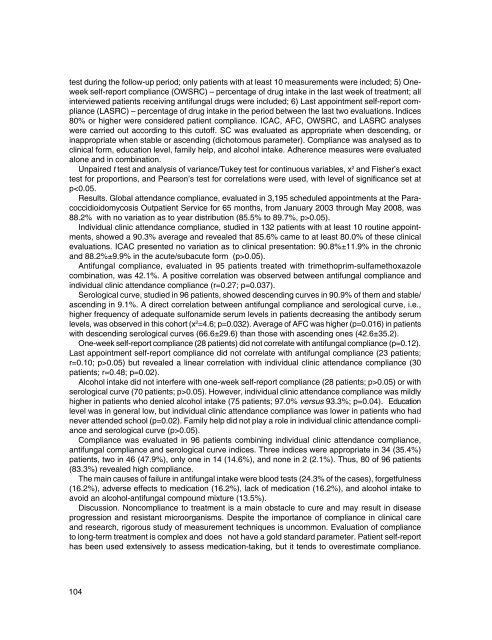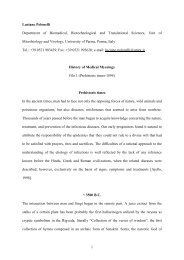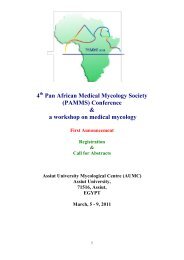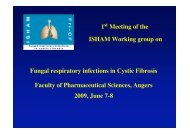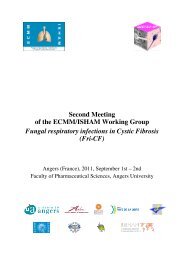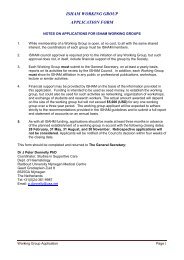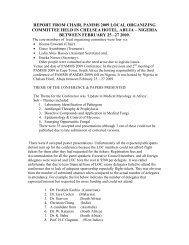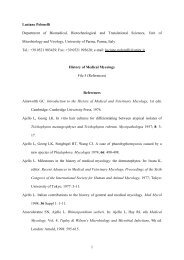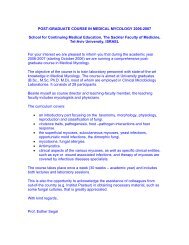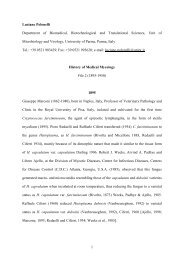Memoria CD.indd - ISHAM
Memoria CD.indd - ISHAM
Memoria CD.indd - ISHAM
Create successful ePaper yourself
Turn your PDF publications into a flip-book with our unique Google optimized e-Paper software.
test during the follow-up period; only patients with at least 10 measurements were included; 5) Oneweekself-report compliance (OWSRC) – percentage of drug intake in the last week of treatment; allinterviewed patients receiving antifungal drugs were included; 6) Last appointment self-report compliance(LASRC) – percentage of drug intake in the period between the last two evaluations. Indices80% or higher were considered patient compliance. ICAC, AFC, OWSRC, and LASRC analyseswere carried out according to this cutoff. SC was evaluated as appropriate when descending, orinappropriate when stable or ascending (dichotomous parameter). Compliance was analysed as toclinical form, education level, family help, and alcohol intake. Adherence measures were evaluatedalone and in combination.Unpaired t test and analysis of variance/Tukey test for continuous variables, x 2 and Fisher’s exacttest for proportions, and Pearson’s test for correlations were used, with level of significance set atp0.05).Individual clinic attendance compliance, studied in 132 patients with at least 10 routine appointments,showed a 90.3% average and revealed that 85.6% came to at least 80.0% of these clinicalevaluations. ICAC presented no variation as to clinical presentation: 90.8%±11.9% in the chronicand 88.2%±9.9% in the acute/subacute form (p>0.05).Antifungal compliance, evaluated in 95 patients treated with trimethoprim-sulfamethoxazolecombination, was 42.1%. A positive correlation was observed between antifungal compliance andindividual clinic attendance compliance (r=0.27; p=0.037).Serological curve, studied in 96 patients, showed descending curves in 90.9% of them and stable/ascending in 9.1%. A direct correlation between antifungal compliance and serological curve, i.e.,higher frequency of adequate sulfonamide serum levels in patients decreasing the antibody serumlevels, was observed in this cohort (x 2 =4.6; p=0.032). Average of AFC was higher (p=0.016) in patientswith descending serological curves (66.6±29.6) than those with ascending ones (42.6±35.2).One-week self-report compliance (28 patients) did not correlate with antifungal compliance (p=0.12).Last appointment self-report compliance did not correlate with antifungal compliance (23 patients;r=0.10; p>0.05) but revealed a linear correlation with individual clinic attendance compliance (30patients; r=0.48; p=0.02).Alcohol intake did not interfere with one-week self-report compliance (28 patients; p>0.05) or withserological curve (70 patients; p>0.05). However, individual clinic attendance compliance was mildlyhigher in patients who denied alcohol intake (75 patients; 97.0% versus 93.3%; p=0.04). Educationlevel was in general low, but individual clinic attendance compliance was lower in patients who hadnever attended school (p=0.02). Family help did not play a role in individual clinic attendance complianceand serological curve (p>0.05).Compliance was evaluated in 96 patients combining individual clinic attendance compliance,antifungal compliance and serological curve indices. Three indices were appropriate in 34 (35.4%)patients, two in 46 (47.9%), only one in 14 (14.6%), and none in 2 (2.1%). Thus, 80 of 96 patients(83.3%) revealed high compliance.The main causes of failure in antifungal intake were blood tests (24.3% of the cases), forgetfulness(16.2%), adverse effects to medication (16.2%), lack of medication (16.2%), and alcohol intake toavoid an alcohol-antifungal compound mixture (13.5%).Discussion. Noncompliance to treatment is a main obstacle to cure and may result in diseaseprogression and resistant microorganisms. Despite the importance of compliance in clinical careand research, rigorous study of measurement techniques is uncommon. Evaluation of complianceto long-term treatment is complex and does not have a gold standard parameter. Patient self-reporthas been used extensively to assess medication-taking, but it tends to overestimate compliance.104


